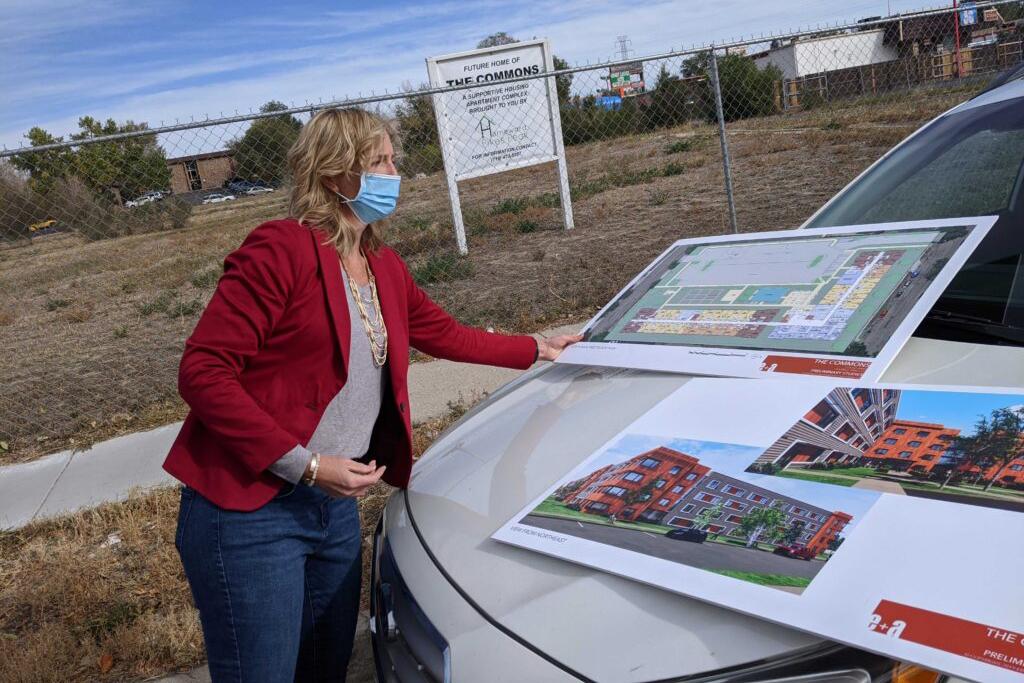
The social worker now doubling as real estate developer could hear the squeak of playground swings in action.
Beth Hall Roalstad, executive director of Homeward Pikes Peak, was visiting a lot that has been empty since a 2009 fire destroyed an old apartment complex. Roalstad plans to use this site to build homes for people who have experienced homelessness.
She spotted a yellow ball on her side of the high fence separating her lot from a church that runs a preschool and after-school programs. Roalstad scooped up the toy and tossed it toward unseen children. In her mind’s eye, perhaps she was seeing the children of families who will live in her apartments. She’s spoken with her future neighbors and knows the preschool’s fees are within reach of low-income families.
Attention to detail is key to building any new housing. Roalstad is learning about the particular complexities of housing that is affordable for people on low or fixed incomes in a state where housing costs have for years risen faster than wages. She is navigating one federal program, in particular, that keeps money flowing to local efforts that help address a national housing affordability crisis.
The Low Income Housing Tax Credit program, created in 1986, offers a tax write-off to banks, insurance companies and others to encourage them to put cash into affordable housing. Builders using cash provided by beneficiaries of tax credits don’t have to take on as much debt as a market-rate developer would, allowing them to charge less rent once the projects are finished, since they aren’t under pressure to satisfy investors’ thirst for big returns.
Another major federal program provides vouchers that low-income renters can use to pay landlords. Roalstad and others across Colorado are watching to see whether action to get more people into homes will be the outcome of campaign-season policy conversations about expanding the tax and subsidy programs.
Roalstad’s Colorado Springs-based nonprofit helps military veterans find homes. Her Homeward Pikes Peak also temporarily houses pregnant women and people recovering from substance abuse, and provides other services to people experiencing homelessness.
The apartment complex known as The Commons planned next door to the church will be Homeward Pikes Peak’s first permanent housing project. It will offer homes to people emerging from homelessness who need a place where they can count on paying no more than a third of their income on rent, a common measure of housing affordability.
A few years ago, Roalstad first heard about the Low Income Housing Tax Credit, or LIHTC, program that made her plans for The Commons possible.
She thought LIHTC, pronounced lye-tech, “sounded like financial wizardry.” Roalstad said the credits that The Commons received this year raised an estimated $10 million to $12 million, more than half the project’s total cost of about $17 million. Dominium, a national affordable housing company based in Minneapolis, is providing development services at no cost for the project.
The federal government allocates credits to each state according to its population. In Colorado, the main LIHTC program has contributed to the building or preservation of 735 affordable units a year between 2015 and 2020, according to the Colorado Housing and Finance Authority.
About half the developers who present LIHTC proposals in Colorado fail to win credits each year. That doesn’t mean they are proposing bad projects, said Jaime Gomez, the chief operating officer and deputy executive director of the Colorado Housing and Finance Authority. It means there aren’t enough credits to meet the need.
LIHTC “is the most important tool available for the construction and rehabilitation of affordable rental properties,” Gomez said.
Roalstad had to try twice before getting her tax credits this year. They will help pay for the first phase of The Commons: 50 one, two- or three-bedroom apartments. Roalstad wants future phases of the project to build 70 more apartments on the two-acre site in a part of Colorado Springs dominated by older apartment buildings and strip malls. She’s still trying to decide how to finance the second phase and when she might start building it.
Upper floor apartments in the first phase’s four-story building will have views of Pikes Peak to the west. The Commons will have a dog run. It will also have its own playground, to supplement the one at the church preschool some younger residents are likely to use. Residents will have support to find jobs, get mentally and physically healthy and take other steps to ensure they remain stably housed. Some might move on, perhaps to rent without federal help or to buy a home.
Roalstad said Colorado Springs could use five more complexes like the one she’s planning, to house the estimated 750 people in the region who are experiencing chronic homelessness. That describes people who have been without stable housing for at least a year, or who have disabilities or other conditions that make it hard for them to hold onto housing.
In the three and a half years since she has headed Homeward Pikes Peak, Roalstad said she has seen rent for a typical one bedroom apartment increase from about $750 a month to $1,100.
“Affordability is the number one reason why people fall into homelessness,” Roalstad said.
The need in Colorado goes far beyond the Pikes Peak region, and developers from across the state have to compete for the same pot of credits.
Last year Housing Solutions of the Southwest, a nonprofit that serves Archuleta, Dolores, La Plata, Montezuma and San Juan Counties, received tax credits for 40 one-bedroom homes, called the Espero Apartments, which like The Commons in Colorado Springs will offer support services and house people who have been chronically homeless. Espero broke ground earlier this month.
Elizabeth Salkind, executive director of Housing Solutions for the Southwest, said that without LIHTC, “I can’t think of how we would have done it.”
Salkind said her nonprofit spent seven years assessing community needs and concerns and seeking the right developer partner before taking the proposal to the Colorado Housing and Finance Authority’s LIHTC competition. The time was well-spent. Espero got its tax credits on the first try.
Espero, like The Commons in Colorado Springs, also relies on the federal housing voucher program, often called Section 8 for the section of federal housing legislation that has its roots in Depression-era efforts to house low-income Americans.
Some vouchers are issued to individuals, and there are general voucher programs as well as programs for specific groups, such as veterans or young people aging out of foster care.
Other vouchers are project-based. Vouchers are attached to all of Espero’s 40 apartments and all of the 50 in the first phase of The Commons. That means tenants will pay 30 percent of their income toward the rent — or nothing if they have no income — while the federal government makes up the rest, up to limits set by U.S. Department of Housing and Urban Development, or HUD. The mashup is not unusual, and means landlords such as Salkind and Roalstad who rely on a flow of federal rent subsidies are able to devote other funds to support programs.
In 2012, the Adams County housing authority got help from a LIHTC program to buy and renovate a 200-unit complex in Thornton known as the Village of Yorkshire. This year, thanks to a project-based voucher, Shanita Waldrop and her three children were able to move from Aurora into the Village of Yorkshire.
Her new apartment is “warm, friendly and inviting,” Waldrop said.
“It was spacious. That was a big thing for me,” she added, saying she has been working from home in her job as a customer service representative since the pandemic struck. “I have my space to actually work.”
Even bigger for her, the rent will never take up more than a third of her earnings. Waldrop had been coping with market rate rents rising $200 or $300 a year.
“It’s almost impossible to live here without multiple jobs or multiple incomes. It’s very stressful,” the single mother said. “It’s very hard when you’re paying $1,300, $1,400 on rent, especially on a place you feel it’s not even worth it.”
She has set out to save toward buying her own home.
“I’m able to somewhat live comfortable and actually work on my goal of homeownership,” she said. “I very much feel like it’s attainable now.”
Waldrop has in the past added her name to waitlists maintained by some landlords who keep their rents below market rates. Waldrop said she’s been told to expect to wait four or five years. She had also been entering voucher lotteries in the Denver area every year since 2011, without success. When she found out she won one at last, she “thought it was an error.”
Across the state, many more people apply for vouchers than receive them.
An estimated 177,000 Colorado households spend at least half their income on rent, according to Jennie Rodgers, vice president and Denver market leader for Enterprise Community Partners, an affordable housing nonprofit. That doesn’t leave much of a cushion, if any, for health care, transportation, other expenses and for savings.
So about 63,000 households rely on federal rent subsidies, Rodgers said. With those subsidies, which increase or decrease according to need, those households are guaranteed to spend no more than a third of their income on rent.
But in Durango, where Housing Solutions of the Southwest supports about 200 households with various kinds of vouchers, Salkind said there is a lengthy voucher waiting list. Likewise, in Adams County where Waldrop finally got lucky this year, about 4,000 people applied for the February voucher lottery, and so far about 50 new vouchers have been issued.
In Denver, nearly 23,000 people entered the annual lottery conducted last month by the Denver Housing Authority. Last year, after a similar number of entries, DHA issued vouchers to fewer than 1,000 people.
Across the country, an estimated three out of four people who are eligible for the housing subsidies are not served because of budget constraints.
Presidential candidate Joe Biden has pledged to provide housing vouchers to every eligible household, saying he will devote resources to both vouchers issued to individual households and those attached to projects such as Espero or The Commons.
The Trump administration has expressed skepticism that more government spending will solve the nation’s housing problem. The drafters of a report released in October by the US Interagency Council on Homelessness argued that “the provision of subsidized or dedicated housing has not led to reducing the total population of people experiencing homelessness,” noting that the number of people living on the streets across the country increased 20 percent between 2014 and 2019.
Robert Marbut, who was appointed last year by President Donald Trump to head the U.S. Interagency Council on Homelessness, has long called for recipients of housing aide to be required to accept services such as mental health care and drug rehabilitation.
The Trump administration has touted its Opportunity Zone program created in 2017 as a way to address the low incomes that prevent people from paying for stable housing. Under the program, wealthy investors can avoid the federal capital gains tax if they reinvest the gains in funds used for development in or near areas where poverty has been entrenched.
Luxury apartments and trendy businesses have sprung up in Opportunity Zones. Peter LiFari, who heads the housing authority in Adams County, is among those who have called for tweaks to the program, such as adding incentives to get developers to form the kinds of partnerships with community organizations typical of LIHTC projects to ensure local needs are met by development undertaken in Opportunity Zones.
LiFari said the Opportunity Zone program should not be seen as an affordable housing program, but as an economic development program that could complement LIHTC.
“LIHTC can serve its specific purpose and OZ’s can serve theirs,” LiFari said.
Ismael Guerrero recently left the helm of Denver’s housing authority to take over Denver-based Mercy Housing, which has housing complexes in 41 states and is one of the country’s largest nonprofit developers and managers of housing that is rented at below market rates. Guerrero said that while Opportunity Zones were worth evaluating to see how they could be more effective, he thought the focus should be on expanding LIHTC and housing vouchers.
“Let’s grow what we know,” Guerrero said.
A legislative effort led by Sen. Maria Cantwell, a Washington Democrat, is working to grow LIHTC. Her Affordable Housing Credit Improvement Act , introduced last year, would, among other things, increase LIHTC allocations by 50 percent over five years. Gomez, of the Colorado Housing and Finance Authority, said the change would mean 400 to 500 more affordable rental units could be created every year in Colorado.
Both Colorado senators — Democrat Michael Bennet and Republican Cory Gardner — are cosponsors of Cantwell’s proposal. John Hickenlooper, the Democrat running to oust Gardner, also has called for expanding the LIHTC program. Cantwell’s proposal has broad bipartisan support, but has not managed to get passed during a busy and contentious federal legislative session.
It’s not all up to the federal government. The state has its own tax credits and other financing mechanisms. Local governments pitch in. Denver has a housing fund financed in part by taxes on marijuana that is used for grants and loans to spur development of below-market-rate housing. Denver’s November ballot includes a proposal to increase the sales tax to raise funds to address homelessness by building housing, improving shelters and providing more substance abuse counseling and other support.
The city of Durango provided land to Housing Solutions for the Southwest for the Espero Apartments. The city of Colorado Springs gave Roalstad’s nonprofit a grant for The Commons.
“There are a lot of things that happen at every level of government that voters could be paying attention to,” Roalstad said.









